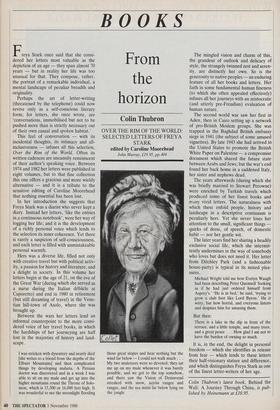BOOKS
From the horizon
Colin Thubron
OVER THE RIM OF THE WORLD: SELECTED LETTERS OF FREYA STARK edited by Caroline Moorehead
John Murray, f19.95, pp.404
Freya Stark once said that she consi- dered her letters most valuable as the depiction of an age — they span almost 70 years — but in reality her life was too unusual for that. They compose, rather, the portrait of a remarkable individual, a mental landscape of peculiar breadth and originality.
Perhaps the art of letter-writing (threatened by the telephone) could now revive only as a self-conscious literary form; for letters, she once wrote, are `conversations, immobilised but not to be pushed more than is strictly necessary out of their own casual and spoken habitat.'
This feel of conversation — with its incidental thoughts, its intimacy and all- inclusiveness — infuses all this selection, Over the Rim of the World. Often its written cadences are uncannily reminiscent of their author's speaking voice. Between 1974 and 1982 her letters were published in eight volumes, but to that fine collection this one offers a gracious and more wieldy alternative — and it is a tribute to the sensitive editing of Caroline Moorehead that nothing essential has been lost.
In her introduction she suggests that Freya Stark was a diarist who never kept a diary. Instead her letters, 'like the entries in,a continuous notebook', were her way of logging her life; and it is the development of a richly personal voice which lends to the selection its inner coherence. Yet there is rarely a suspicion of self-consciousness, and each letter is filled with unmistakeable personal warmth.
Hers was a diverse life, filled not only with creative travel but with political activ- ity, a passion for history and literature, and a delight in society. In this volume her letters begin at the age of 21, on the eve of the Great War (during which she served as a nurse during the Italian ddbacle at Caporetto) and end in 1980 in retirement (but still dreaming of travel) in the Vene- tian hill-town of Asolo, where she was brought up.
Between the wars her letters lend an informal counterpoint to the more consi- dered voice of her travel books, in which the hardships of her journeying are half lost in the majesties of history and land- scape.
I was stricken with dysentery and nearly died [she writes to a friend from the depths of the Elburz Mountains] and then complicated things by developing malaria. A Persian doctor was discovered and in a week I was able to sit on my mule and get up into the higher mountains round the Throne of Solo- mon, which is 15,500 or 16,000 feet high. It was wonderful to see the moonlight flooding those great slopes and hear nothing but the wind far below — I could not walk much . . . My two muleteers were so devoted; they sat me up on my mule whenever it was barely possible, and we got to the top somehow, and there saw the Vision of Demavend streaked with snow, across ranges and ranges, and the sea mists far below lying on the jungle.
The mingled vision and charm of this, the grandeur of outlook and delicacy of style, the strangely twinned zest and seren- ity, are distinctly her own. So is the generosity to native peoples — an enduring feature of all her books and letters. Her faith in some fundamental human fineness (to which she often appealed effectively) infuses all her journeys with an aristocratic (and utterly pre-Freudian) evaluation of human nature.
The second world war saw her first in Aden, then in Cairo setting up a network of pro-British Moslem groups. She was trapped in the Baghdad British embassy siege in 1941 (the subject of some amused vignettes). By late 1943 she had arrived in the United States to promote the British White Paper on Palestine — a compromise document which shared the future state between Arabs and Jews; but the war's end found her back home in a saddened Italy, her sister and nephews dead.
The years afterwards (during which she was briefly married to Stewart Perowne) were enriched by Turkish travels which produced some of her finest books and many vivid letters. The naturalness with which these enfold people, history and landscape in a descriptive continuum is peculiarly hers. Yet she never loses her attention to the small, significant things quirks of dress, of speech, of domestic habit — nor her gentle wit.
The later years find her sharing a headily exclusive social life, which she intermit- tently undermines in the way of somebody who loves but does not need it. Her letter from Ditchley Park (and a fashionable house-party) is typical in its mixed plea- sures.
Michael Wright told me how Evelyn Waugh had been describing Peter Quennell 'looking as if he had just ordered himself from Asprey's."He is in bed,' he said, 'trying to grow a club foot like Lord Byron.' He is witty, but how horrid, and everyone listens and despises him for amusing them.
But then:
There is a lake in the dip in front of the terrace, and a little temple, and many trees, and a great peace . . . How glad I am not to have the burden of owning so much.
It is, in the end, the delight in personal freedom — which she identifies as release from fear — which lends to these letters their half-visionary stature and difference, and which distinguishes Freya Stark as one of the finest letter-writers of her age.
Colin Thubron's latest book, Behind the Wall: A Journey Through China, is pub- lished by Heinemann at £10.95.


































































 Previous page
Previous page